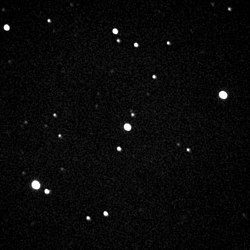| Observation data Epoch J2000 Equinox J2000 | |
|---|---|
| Constellation | Andromeda [1] |
| Right ascension | 00h 20m 40.0746s [2] |
| Declination | +31° 59′ 23.955″ [2] |
| Apparent magnitude (V) | 11.68 ± 0.05 [3] |
| Characteristics | |
| WASP-1A | |
| Evolutionary stage | main-sequence star |
| Spectral type | F7V [4] |
| Apparent magnitude (B) | ~12.0 [5] |
| Apparent magnitude (V) | 11.68 ± 0.05 [3] |
| WASP-1B | |
| Apparent magnitude (H) | 15.130 ± 0.046 [6] |
| Apparent magnitude (K) | 15.116 ± 0.055 [6] |
| Astrometry | |
| WASP-1A | |
| Radial velocity (Rv) | −13.90(59) [2] km/s |
| Proper motion (μ) | RA: −4.692(22) mas/yr [2] Dec.: −3.320(20) mas/yr [2] |
| Parallax (π) | 2.6108±0.0218 mas [2] |
| Distance | 1,250 ± 10 ly (383 ± 3 pc) |
| Absolute magnitude (MV) | 3.63+0.13 −0.14 [3] |
| Details [3] | |
| WASP-1A | |
| Mass | 1.301+0.049 −0.047 M☉ |
| Radius | 1.515+0.052 −0.045 R☉ |
| Luminosity | 2.88+0.36 −0.30 L☉ |
| Surface gravity (log g) | 4.190+0.020 −0.022 cgs |
| Temperature | 6110±75 K |
| Metallicity [Fe/H] | 0.26±0.08 dex |
| Age | 3.0±0.6 Gyr |
| WASP-1B | |
| Mass | ~0.3 [6] : 13 M☉ |
| Surface gravity (log g) | ~4.97 [6] : 13 cgs |
| Temperature | ~3400 [6] : 13 K |
| Position (relative to WASP-1A) [6] : 11, 13 | |
| Component | WASP-1B |
| Epoch of observation | 2013–2014 |
| Angular distance | ~4.58″ |
| Position angle | ~1.9° |
| Projected separation | 1587+160 −16 AU |
| Other designations | |
| 1SWASP J002040.07+315923.7, USNO-B1.0 1219-00005465, TOI-6014, TIC 57984377, WASP-1, TYC 2265-107-1, GSC 02265-00107, 2MASS J00204007+3159239 [5] | |
| Database references | |
| SIMBAD | data |
| Exoplanet Archive | data |
WASP-1 is a magnitude 12 binary star system located about 1,250 light-years away [2] in the Andromeda constellation. [7] The binary system consists of a metal-rich F-type main-sequence star, named WASP-1A, and a distant low-mass star, named WASP-1B. WASP-1A has one known transiting hot Jupiter exoplanet named WASP-1b.
